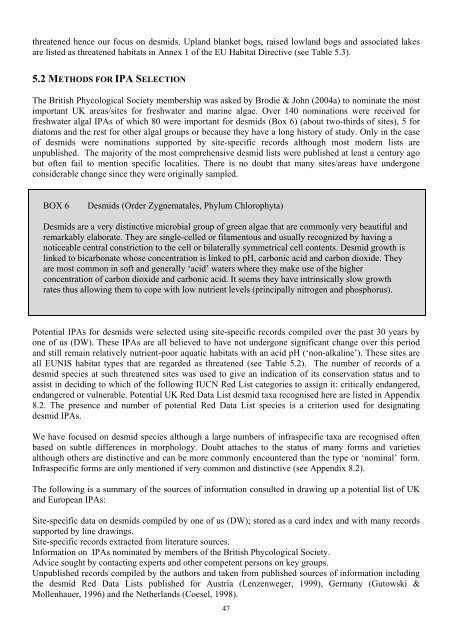Important Plant Areas for algae - Natural History Museum
Important Plant Areas for algae - Natural History Museum
Important Plant Areas for algae - Natural History Museum
You also want an ePaper? Increase the reach of your titles
YUMPU automatically turns print PDFs into web optimized ePapers that Google loves.
threatened hence our focus on desmids. Upland blanket bogs, raised lowland bogs and associated lakes<br />
are listed as threatened habitats in Annex 1 of the EU Habitat Directive (see Table 5.3).<br />
5.2 METHODS FOR IPA SELECTION<br />
The British Phycological Society membership was asked by Brodie & John (2004a) to nominate the most<br />
important UK areas/sites <strong>for</strong> freshwater and marine <strong>algae</strong>. Over 140 nominations were received <strong>for</strong><br />
freshwater algal IPAs of which 80 were important <strong>for</strong> desmids (Box 6) (about two-thirds of sites), 5 <strong>for</strong><br />
diatoms and the rest <strong>for</strong> other algal groups or because they have a long history of study. Only in the case<br />
of desmids were nominations supported by site-specific records although most modern lists are<br />
unpublished. The majority of the most comprehensive desmid lists were published at least a century ago<br />
but often fail to mention specific localities. There is no doubt that many sites/areas have undergone<br />
considerable change since they were originally sampled.<br />
BOX 6<br />
Desmids (Order Zygnematales, Phylum Chlorophyta)<br />
Desmids are a very distinctive microbial group of green <strong>algae</strong> that are commonly very beautiful and<br />
remarkably elaborate. They are single-celled or filamentous and usually recognized by having a<br />
noticeable central constriction to the cell or bilaterally symmetrical cell contents. Desmid growth is<br />
linked to bicarbonate whose concentration is linked to pH, carbonic acid and carbon dioxide. They<br />
are most common in soft and generally ‘acid’ waters where they make use of the higher<br />
concentration of carbon dioxide and carbonic acid. It seems they have intrinsically slow growth<br />
rates thus allowing them to cope with low nutrient levels (principally nitrogen and phosphorus).<br />
Potential IPAs <strong>for</strong> desmids were selected using site-specific records compiled over the past 30 years by<br />
one of us (DW). These IPAs are all believed to have not undergone significant change over this period<br />
and still remain relatively nutrient-poor aquatic habitats with an acid pH (‘non-alkaline’). These sites are<br />
all EUNIS habitat types that are regarded as threatened (see Table 5.2). The number of records of a<br />
desmid species at such threatened sites was used to give an indication of its conservation status and to<br />
assist in deciding to which of the following IUCN Red List categories to assign it: critically endangered,<br />
endangered or vulnerable. Potential UK Red Data List desmid taxa recognised here are listed in Appendix<br />
8.2. The presence and number of potential Red Data List species is a criterion used <strong>for</strong> designating<br />
desmid IPAs.<br />
We have focused on desmid species although a large numbers of infraspecific taxa are recognised often<br />
based on subtle differences in morphology. Doubt attaches to the status of many <strong>for</strong>ms and varieties<br />
although others are distinctive and can be more commonly encountered than the type or ‘nominal’ <strong>for</strong>m.<br />
Infraspecific <strong>for</strong>ms are only mentioned if very common and distinctive (see Appendix 8.2).<br />
The following is a summary of the sources of in<strong>for</strong>mation consulted in drawing up a potential list of UK<br />
and European IPAs:<br />
Site-specific data on desmids compiled by one of us (DW); stored as a card index and with many records<br />
supported by line drawings.<br />
Site-specific records extracted from literature sources.<br />
In<strong>for</strong>mation on IPAs nominated by members of the British Phycological Society.<br />
Advice sought by contacting experts and other competent persons on key groups.<br />
Unpublished records compiled by the authors and taken from published sources of in<strong>for</strong>mation including<br />
the desmid Red Data Lists published <strong>for</strong> Austria (Lenzenweger, 1999), Germany (Gutowski &<br />
Mollenhauer, 1996) and the Netherlands (Coesel, 1998).<br />
47

















